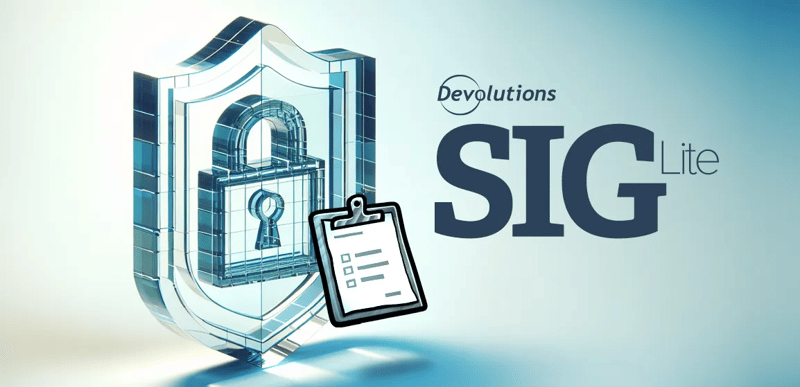The Higher Education Community Vendor Assessment Toolkit (HECVAT) is a standardized framework designed to help higher education institutions evaluate the cybersecurity posture of their third-party vendors and service providers. It ensures that organizations handling institutional data have the appropriate controls in place to safeguard privacy, confidentiality, and availability.
While HECVAT originated in academia, its principles apply far beyond. For organizations managing sensitive data or IT environments, aligning with HECVAT demonstrates strong governance, transparency, and commitment to security best practices.
At Devolutions, we understand the growing need for measurable security assurance. Our solutions — Devolutions Server (DVLS), Devolutions Hub, and Remote Desktop Manager (RDM) — provide the technical foundation required to meet key HECVAT controls, including access management, traceability, and credential protection.
It is important to note that HECVAT is not a security framework, but rather a questionnaire-based assessment tool. Its purpose is to help institutions evaluate how vendors implement and maintain essential security controls. In this sense, HECVAT consolidates and references many of the same control categories found in other established frameworks — such as ISO/IEC 27001, NIST 800-53, or CIS Controls — but presents them in a standardized format that simplifies vendor risk assessments.
Devolutions’ solutions align with these underlying control families, helping organizations strengthen their practices in areas like identity management, access governance, data protection, and incident traceability.
How Devolutions solutions support HECVAT compliance
1. Role-Based Access Control (RBAC) – DVLS & Hub
Access management is one of the cornerstones of HECVAT. The framework requires clear documentation of who has access to systems and why.
With DVLS and Hub Business, organizations can:
- Define custom user roles (e.g., Administrators, IT Staff, Contractors).
- Apply granular permissions at the vault or entry level (read, modify, delete).
- Enforce least privilege access, ensuring that users only access what is necessary.
HECVAT Alignment: These capabilities support compliance with access control requirements by formalizing authorization policies and reducing the risk of privilege misuse.
2. Audit Logging and Traceability – DVLS & Hub
HECVAT emphasizes the need for auditability and accountability. Every privileged action should be traceable and reviewable.
DVLS & Hub automatically logs:
- Every access, password modification, or data export.
- Administrative and user activities across sessions.
- Detailed audit trails that can be exported for compliance or incident investigations.
HECVAT Alignment: Comprehensive audit logging enables demonstrable accountability and facilitates both internal and external reviews.
3. Centralized Credential Management – RDM + DVLS/Hub
Credential management remains a critical control in any security framework. HECVAT expects organizations to protect credentials from unauthorized disclosure and ensure secure handling across systems.
By integrating RDM with DVLS or Hub, you can:
- Store all sensitive credentials in a centralized, encrypted repository.
- Facilitate secure password transmission and sharing practices.
- Use credential injection to authenticate sessions without revealing passwords.
HECVAT Alignment: Centralized management and encryption of credentials directly address HECVAT’s requirements for secure secret management and data protection.
4. Remote Session Monitoring & Control – RDM + DVLS
In a distributed IT landscape, controlling and monitoring remote sessions is essential. HECVAT evaluates how remote access is secured, monitored, and audited.
Using RDM with DVLS, organizations can:
- Record remote sessions (e.g., RDP, SSH) for accountability and oversight.
- Restrict access to predefined credentials, systems, and tools.
- Remotely terminate sessions if suspicious activity occurs.
HECVAT Alignment: Provides verifiable control and visibility over remote connections, satisfying HECVAT’s remote access monitoring expectations.
Demonstrating trust and transparency through Conveyor
To simplify due diligence for higher education institutions and procurement teams, Devolutions provides a pre-completed HECVAT via Conveyor — our centralized trust portal.
Through Conveyor, clients and partners can:
- Instantly access our completed HECVAT Full questionnaire.
- Review complementary documentation, including:
- SOC 2 Type II report
- ISO/IEC 27001 and 27701 certifications
- Penetration test summaries
- Download all relevant compliance materials from a single, verified source.
HECVAT Alignment: Devolutions not only helps organizations meet HECVAT standards — we also apply them ourselves and make our compliance documentation readily available.
Conclusion
HECVAT provides a structured, transparent approach to evaluating and communicating security practices between institutions and their vendors. For organizations aiming to align with this framework, Devolutions offers both the tools and the proof of compliance.
By implementing role-based access control, audit logging, centralized credential management, and session monitoring, Devolutions solutions empower IT teams to demonstrate maturity, control, and trustworthiness.
To learn more or access Devolutions’ completed HECVAT and other certifications, visit our Trust Center.



